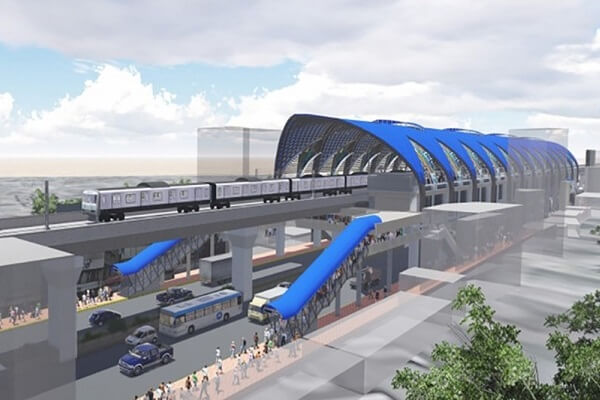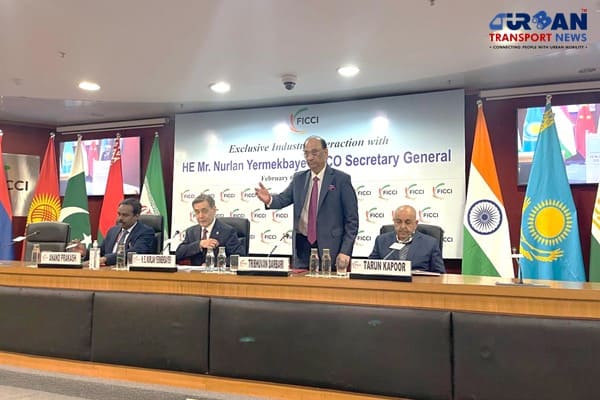 Delhi unveils ambitious Urban Mobility Vision: Luxury Metro Coaches, New Tunnels and Pod Taxi
Delhi unveils ambitious Urban Mobility Vision: Luxury Metro Coaches, New Tunnels and Pod Taxi Qatar approves Saudi Rail Link Agreement, Accelerating Gulf Railway Vision 2030
Qatar approves Saudi Rail Link Agreement, Accelerating Gulf Railway Vision 2030 UP Govt plans to introduce Water Metro services in Ayodhya, Varanasi & Prayagraj
UP Govt plans to introduce Water Metro services in Ayodhya, Varanasi & Prayagraj India’s First Urban Ropeway begins Trial Run in Varanasi, Set to carry 1 Lakh passengers daily
India’s First Urban Ropeway begins Trial Run in Varanasi, Set to carry 1 Lakh passengers daily India and Bhutan to Build First-Ever Rail Link: ₹4,033 Cr Project to Boost Regional Connectivity
India and Bhutan to Build First-Ever Rail Link: ₹4,033 Cr Project to Boost Regional Connectivity Patna to launch Eco-Friendly Water Metro; Trial Run soon between Digha and Kangan Ghats
Patna to launch Eco-Friendly Water Metro; Trial Run soon between Digha and Kangan Ghats Air India Group set to launch Flights Operations from Navi Mumbai International Airport
Air India Group set to launch Flights Operations from Navi Mumbai International Airport Chennai to launch 25-Year Mobility Plan with Unified QR Ticketing and One-App Transit System
Chennai to launch 25-Year Mobility Plan with Unified QR Ticketing and One-App Transit System Kochi Metro bags ₹4.4 crore contract to prepare DPR for Mumbai Water Metro Proejct
Kochi Metro bags ₹4.4 crore contract to prepare DPR for Mumbai Water Metro Proejct Navi Mumbai International Airport set for September launch; IndiGo and Akasa Air to lead Operations
Navi Mumbai International Airport set for September launch; IndiGo and Akasa Air to lead Operations
AMRUT can transform urban reforms, but projects for Leh facing trouble

Jammu/Urban Transport News: Projects under Atal Mission for Rejuvenation and Transformation (AMRUT) are facing rough weather in Leh due to the insufficient response from the contractors. The Administration, therefore, is apprehensive about the projects completed within the time frame fixed by the Union Ministry of Housing and Urban Affairs. It may be recalled that this flagship welfare scheme was launched by the Central Government in the year 2015.
Jammu, Srinagar, Anantnag, Leh, and Kargil were selected for infrastructure creation as per the guidelines of the Mission. Water supply, sewerage and septage, stormwater drainage, Urban Transport, and green space and parks are the areas covered chiefly under the Mission. The main problem faced at the execution level is the provision of adequate funds not reaching in time but in the instant case, funds are already released beforehand.
Repeated tenders for supplying of suckers and jetting machines are not yielding any fruitful results. The same is true of other tendering processes and procuring of necessary equipment. Could any remedy or resolution of the non-response from contractors be found out so that the already delayed projects could be started with added pace? It is reported that no major headway, as on date, is made on projects under AMRUT which is a cause of concern. If more delay took place, that would mean cost escalation besides people of the area deprived of the benefits which otherwise would flow from out of the Mission projects.
About Amrut: India’s tryst with comprehensive urban reforms started with the 74th Constitutional Amendment Act in 1992 to empower cities. Thirteen years later, in December 2005, the Jawaharlal Nehru National Urban Renewal Mission (JNNURM) was launched, scripting a comprehensive agenda for seven years through 23 reforms (13 mandatory and 10 optional), to be implemented by States and urban local bodies (ULBs). But an evaluation of JNNURM in 2013 found States and ULBs unable to stick to reforms, delays in the release of additional central assistance and manifold hindrances to project completion.
Then in June 2015, the Atal Mission for Rejuvenation and Urban Transformation (AMRUT) programme was launched by the Ministry of Urban Development (MoUD), which included 11 reforms dotted with 54 milestones, to be implemented by all 500 mission cities in four years. Recently, MoUD modified the AMRUT reform matrix, creating a template that enables States and cities to go beyond incrementalism and implement transformational changes over three years.
The template spells out five major reforms, such as ‘Trust and verify’, which will have 40 percent weight, ‘Professionalisation of municipal cadre’ (25 per cent), ‘Land titling law’ (15 per cent), and ‘Credit rating’ and ‘Value capture finance’ (10 per cent each). The takeaway from JNNURM and the initial phase of AMRUT was that comprehensive and overarching reforms are difficult to pull off in one big sweep.
So AMRUT alters the approach in two ways: First, the number of reforms aimed at has been reduced and separated from project assistance. Second, shifted focus from penalization to incentivization. AMRUT now sets aside 10 percent of funds for incentives to be given based on self-assessment by ULBs and corroborated by State-level high-powered steering committees based on the report of independent monitoring agencies.
While AMRUT cascades the autonomy to design, monitor and approve projects to states and civic bodies, it also persuades local stakeholders to put more skin in the game by participating in an execution. And the corpus of the Reforms Incentive Fund, accessible to those adhering to mandates and milestones, has been increased six-fold to ₹3,300 per annum for the next three years.
Brief Information About Amrut: The Centre is also increasingly looking at impact-oriented urban programmes where States and ULBs take more responsibility for implementation and sustaining urban infrastructure. So traditional grant-based programmes are being embedded with impact and outcome milestones. Under AMRUT, the professionalization of municipal cadre, land titling law, and policy for value capture finance are State prerogatives and have a far-reaching impact on the local landscape. And all this comes at a time when expectations of citizens on livability standards across cities are growing fast. History shows that reforms succeed when stakeholders take ownership.
That’s why the Economic Survey last fiscal reiterated ‘cooperative and competitive federalism’ as India’s unavoidable future. It argues for cities to be entrusted with responsibilities, empowered with resources, and encumbered by accountability to transform into vehicles of competitive federalism. In that context, AMRUT rightly puts states and ULBs in the driver’s seat. JNNURM was considered to have big city bias. AMRUT has cast the net wider, reaching all urban centers with a population of one lakh and more.
Under the programme, the number of reforms expected from States and ULBs has decreased, but the number of cities expected to adhere to reforms has increased. While higher fund allocation to transform urban agenda is certainly a key part of the urban revival mission, there is a growing acknowledgment that cities that sustain themselves through enhanced revenues, fewer capital transfers, and efficient internal systems become the beacons of the new urban agenda. And above all, financing remains a multi-trillion-rupee question.
A high-powered expert committee of the MoUD had in 2011 estimated total capital investments in urban infrastructure at about ₹39 lakh crore over 20 years. The Smart City Mission and AMRUT have outlays of ₹48,000 crore and ₹50,000 crore, respectively. That means humongous investments have to be mobilized. Earlier, several committees have elaborated upon various tax and non-tax revenue improvement measures for municipalities. Looking at the track record of urban reforms and estimates to fill service gaps, one of the recommendations relates to ULBs resorting to market borrowings (pooled finance, municipal bonds, and institutional finance) and project execution mechanisms such as public-private partnerships and land-based financing instruments.







